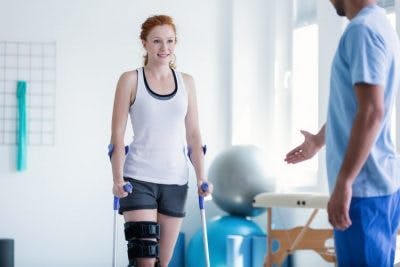Is a full recovery after spinal cord injury possible?
Damage to the spinal cord can’t repair itself the same way as the rest of the body; however, that doesn’t necessarily mean that the functional effects of SCI are permanent.
To clear up whether full recovery after spinal cord injury is possible, this article will discuss:
- The Outcomes of Spinal Cord Injury
- Is Full Recovery After Spinal Cord Injury Realistic?
- Interventions to Promote Full Recovery After SCI
- Promising Treatments for Spinal Cord Injury Recovery
Understanding Outcomes of Spinal Cord Injury
Before we explain whether a full recovery after spinal cord injury is possible, it’s essential to understand the outcomes of SCI.
The spinal cord is responsible for relaying messages between the brain and body. Sensory information travels from the body, up the spinal cord, to the brain. Then, the brain interprets those stimuli and then sends signals back down the spinal cord to the body.
Following a spinal cord injury, the transmission of these messages gets blocked or disrupted, resulting in weak movements or paralysis below your level of injury as well as possible sensory deficits. Level of injury refers to the lowest segment of the spinal cord where movement and sensation are not affected.
The higher your level of injury, the more areas of your body will be affected. However, this will also depend on the severity of your injury.
Those with milder spinal cord lesions will have more spared neural pathways, which have the potential to adapt and recover damaged functions. In contrast, complete spinal cord injuries will result in no spared neural pathways, which generally results in a more limited recovery outlook.
Now that you understand how spinal cord injury affects the body, let’s talk about recovery.
Is a Full Recovery After Spinal Cord Injury Possible?

Generally, when you get injured, the body will heal itself with enough time. This is because most cells in the body are constantly regenerating. However, damaged nerve cells (neurons) in the central nervous system are unable to regenerate. Therefore, damage to the spinal cord is permanent.
While the central nervous system may not be able to heal itself like other parts of the body, it has its own special healing mechanism: neuroplasticity.
The Mechanism Underlying Spinal Cord Injury Recovery
While damage to the spinal cord cannot reverse itself, the spinal cord is capable of utilizing neuroplasticity. Neuroplasticity is the central nervous system’s ability to make neuroadaptive changes based on our behaviors.
Spinal cord injury recovery relies heavily on spared neural pathways and their ability to adapt. The less severe your spinal cord injury is, the more spared neural pathways you’ll have, and the better the potential for recovery.
Recovery after SCI is not based on the regeneration of neurons. Rather, it focuses on promoting neuroplasticity and building new connections between spared neural pathways.
The main function of neurons is to process and transmit information to one another. Connections between neurons can be strengthened or weakened depending on how often they’re stimulated.
Therefore, neuroplasticity is all about stimulating the spinal cord through highly repetitive and task-specific practice. Consistently practicing weakened movements stimulates the spinal cord and reinforces demand for those functions.
Timing and Intensity Matter
Two factors that significantly affect the rate at which spinal cord injury recovery occurs are timing and intensity of rehabilitation.
Timing is important because the majority of motor recovery occurs within the first 6-9 months after injury (with the most rapid rate of recovery occurring within the first 3 months). This is because the spinal cord experiences heightened levels of neuroplasticity as it tries to stabilize itself. Spontaneous recovery typically plateaus at 12-18 months.
However, neuroplasticity never completely goes away, and spared neural pathways are always capable of adapting, even years after SCI.
The intensity that you approach your rehabilitation with also plays a crucial role in your recovery. The harder, longer, and more frequently you perform those repetitions, the quicker results will come.
Management Interventions to Promote Spinal Cord Injury Recovery

Every spinal cord injury and its recovery are unique. Therefore, a personalized approach that focuses on your specific functional abilities is ideal for optimal recovery.
Interventions that can help promote recovery after spinal cord injury include:
- Physical therapy. At PT, you’ll learn exercises you can practice to stimulate spared neural pathways. A physical therapist helps guide you through exercises to target weakened muscles, and will teach you how to safely and effectively move around with your new deficitis.
- Occupational therapy. OT helps individuals become more independent after injury by focusing on practicing activities of daily living. Activities of daily living are typically performed multiple times a day, making them a practical way to get your repetitions in.
- Home exercises. Practicing physical therapy exercises at home and engaging in your activities of daily living as much as possible, is essential for optimizing neuroplasticity and functional improvements.
- Botox injections. Many individuals with SCIs struggle with spasticity (involuntary muscle contractions), which affect their movements. Botox injections can help temporarily relieve these contractions, so individuals can focus on practicing their rehab exercises.
- Orthotics. Orthotics like braces and splints can help promote correct musculoskeletal alignment and reduce the progression of spasticity.
Spinal cord injury recovery is complex and many of its underlying mechanisms have yet to be understood. In the following section, we’ll review what current research suggests for the future of SCI recovery.
The Future for Spinal Cord Injury Recovery
As previously mentioned, recovery after spinal cord injury is highly dependent on the severity of injury. Those with more spared neural pathways have a better recovery outlook.
But is there hope for individuals with very severe or complete spinal cord injuries? Below, we’ll discuss promising interventions that suggests a very hopeful future.
Stem Cell Therapy
There are 2 properties of stem cells that make them a very promising treatment for spinal cord injury recovery:
- they can differentiate into a wide variety of cell types depending on their environment
- they can divide infinitely
The idea is to inject them into the spinal cord so that they can replace damaged neurons and restore neural circuitries.
However, stem cell therapy for spinal cord injuries is still very much a work in progress. Researchers are working to understand what the best type of stem cell to use is, a safe dosage, timing, and the long-term effects of the therapy.
Electrical Stimulation
Another promising treatment is electrical stimulation. It involves using electric currents that mimic brain signals to stimulate areas below the level of injury.
This study shows that a combination of intensive physical training and epidural electrical stimulation can improve motor functions in individuals with motor complete injuries. Additionally, all 4 participants started the study at least 2.5 years after their spinal cord injuries (proving that recovery is not limited to a certain amount of time).
Exoskeletons
One option that is currently available to help individuals with spinal cord injuries get on their feet again is wearing an exoskeleton.
Exoskeletons are wearable robotics that use sensors and momentum to facilitate movements. This is ideal for individuals with severe or complete spinal cord injuries. It allows them to get on their feet and move around, which helps promote circulation, reduce muscle atrophy, maintain bone density, and decrease the risk of developing pressure sores.
Full Recovery After Spinal Cord Injury: Key Points
So, is a full recovery after spinal cord injury possible? Your spinal cord may never physically be the same, but that doesn’t mean functions cannot be recovered.
Recovery after spinal cord injury involves promoting neuroplasticity through massed practice of weakened functions. Ultimately, you’re reteaching your brain, spinal cord, and body to work in sync again.
Hopefully, this article helped you understand that there is a hopeful future for spinal cord injury recovery and that as long as you’re willing to put in the work, there is potential for improvement.
Need more inspiration? Check out these spinal cord injury recovery stories!
image credits: iStock/Boonyachoat/kzenon/KatarzynaBialasiewicz











